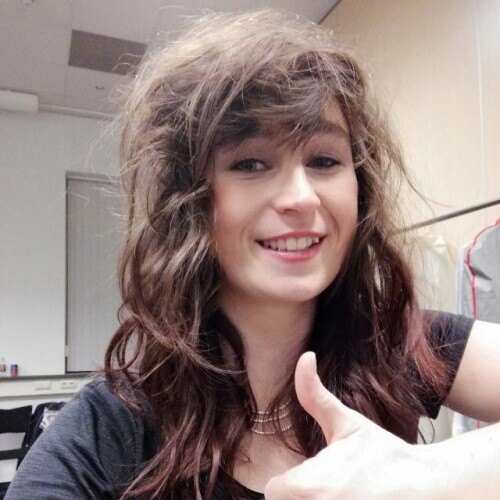2D GAME ARTIST COURSE
6 WEEKS
MONDAYS & WEDNESDAYS
5 PM GMT
6 MAY 2025 - 11 JUN 2025
DURATION:
6 WEEKS
MONDAYS & WEDNESDAYS
5 PM GMT
Transform your ideas into immersive game worlds! Create stunning 2D visuals, from concept art to gameplay assets, and build a portfolio that sets you apart in the gaming industry.
Join Zoé Nguyen Thanh, an Art Director with 10+ years of industry experience, to develop the skills to bring your dream to life.
WHO THIS COURSE IS FOR
-
YOU’RE A SELF-TAUGHT ARTIST
Unsure how to turn your ideas into your industry ‘break’? Our 2D artist course will develop your artistic skills in the game space, and you’ll leave with a professional portfolio you can showcase in interviews.
-
YOU’RE A GAME ARTIST WANTING TO BUILD YOUR PORTFOLIO
Hone your skills and develop a world-class portfolio! Build your work across 9 practical assignments, then compile the best works into a cohesive portfolio that showcases your creative and technical proficiency.
-
YOU WANT TO TRANSITION INTO GAME ART FROM ANOTHER FIELD
No game art background? No problem! Explore the processes of a 2D game artist and develop the essential skills in creating thumbnails, worldbuilding, and character posing sheets. Receive expert guidance from a top industry professional.
Transform your ideas into stunning game visuals.
Game art tells a story. Connect with players through immersive worldbuilding, engaging characters, and gameplay assets. Hone your skills through multiple practical assignments and hands-on workshops.
The classroom is virtual, but the results are real!
Develop the essential hard & soft skills needed to break into the games industry LIVE from a top professional. Leave the course with a bespoke portfolio that showcases your abilities and helps you land work.
- Has worked on impressive titles including “Return to Monkey Island”, “Rime” and “The Sexy Brutale”.
- Develops games with teams across the world.
- Creates unique visuals by using elements from comic books, animated films and picture books.
- Specialises in bringing fresh new styles to the video game landscape.
- Believes in nurturing creative chemistry to allow each personality of the game production team to shine.

- Instructor Introduction
- Course Structure & Outcomes
- Assignments & Projects
- Q&A
Let’s begin! You'll discover what it takes to be a 2D artist, learn the visual "cheat codes" that guide players, and pick up tips on using perspective, light, shadow, and colour to shape immersive game worlds.
- Overview of the 2D artist role
- Key skills and qualifications
- Introduction to game art and visual guidance
- Essentials of perspective, light, shadow, colour, and shape
- Case study: Return to Monkey Island
Assignment #1: Reverse Moodboard
Select a visually appealing game and create a moodboard that imagines the references used to achieve its style.
Explore the role of a concept artist, create compelling thumbnails, and understand exactly how and when the visual dev stage wraps up. Time to sharpen the pencils and get creative.
- Role of a 2D artist in visual development
- Concept art & thumbnails
- Expectations for the visual development stage & its conclusion
Assignment #2: Concept Thumbnails
Generate thumbnails for an environment and a character based on a brief or your personal project.
Dive into concept art creation by experimenting with thumbnails, nailing down perspective, light, and colour, and refining your ideas through feedback. Get hands-on with mood boards and learn how to finalize your concepts (with a few AI tips along the way).
- Thumbnails & iterations
- Perspective, light, atmosphere, colour, and shapes
- Mood boards & references
- Finalising concepts
- AI usage: Best practices
- Presentation techniques & feedback
Assignment #3: Concept Pitch
Finalise a concept for your environment and character based on your previous thumbnails and pitch it in writing.
Art bibles — what they are, why they're crucial, and how they keep your game’s style on point. Get practice pitching your concept art and learn what it takes to work with a known IP. Plus, it’s time to show off your ideas in a mini pitch session!
- Understanding art bibles: Purpose & usage
- Ensuring style consistency & coherence
- Expectations from an art bible and art director
- Collaborating with IPs
- Workshop: Concept pitch
Learn how to craft immersive visual stories that speak louder than words, keep players hooked, and make every scene count without distracting from gameplay. Explore world-building techniques that build anticipation and use style to amplify your narrative.
- Visual storytelling & world-building
- Storytelling without words
- Building anticipation
- Prioritising player focus in scenes
- The medium is the message: Style and story in control
- Case studies: Guacamelee, Hollow Knight, Night in the Woods, Persona 5, Control, and The Last of Us
Assignment #4: Engaging Environment
Design a scene with storytelling and interactive elements in concept art, using a provided brief or your own pitch.
In this class, we'll explore different UI approaches, uncover platform differences, and hear from a guest speaker about essential UI principles. Plus, we'll dissect popular mobile games to see how the pros do it.
- Exploring various UI approaches
- Platform differences in UI design
- Guest speaker: General UI principles
- Introduction to 2D VFX for artists
- Case study: Persona 5, Subway Surfers
Assignment #5: UI Design & Animation (Optional)
Propose a UI design for the screen from your visual storytelling assignment or the brief, and animate at least one element of the UI.
Explore how to adapt 2D designs for both 2D and 3D games. From creating smooth 2D sprites to tackling puppet animation, you'll learn what it takes to bring characters to life across different styles — featuring case studies of 2D and 3D games.
- 2D design for 3D
- 2D design for 2D
- 2D sprites & puppet animation
- Case study: Cuphead, Ori and the Blind Forest, The Sexy Brutale, Persona 5
Assignment #6: Character Posing Sheet
Create an initial character posing sheet using the character from the brief, a previous assignment, or a new character, considering rigging and genre.
Get ready to design props and assets that aren't just functional, but essential to the story. You’ll dive into tilesets, asset optimisation, and collaboration with narrative and game designers — all while studying how The Sexy Brutale nailed it.
- Designing gameplay assets
- Tilesets & optimising by reusing assets
- Collaborating with narrative & game designers
- Collectibles
- Important assets
- Case study: The Sexy Brutale
Assignment #7: Gameplay Asset
Design a gameplay asset, collectible, or custom item based on the brief or your previous character design exercise.
Analyse art styles, stick to character traits, and expand beloved universes. Also, unpack the magic behind Kingdom Hearts as a case study. Transform your creative visions while staying true to the originals.
- Analysing the IP's art style
- Adhering to established character traits & environments
- Matching textures & materials
- Expanding the universe
- Case study: Kingdom Hearts
In Class 10, you'll analyse epic sequences, explore key storyboarding principles, and discover how effective storyboarding can elevate video game production — plus, we'll look at some cool case studies.
- Analysing sequences
- Storyboarding principles
- Storyboarding in video game production
- 2D animatics & studio co-productions
- Case study: Deadlight, Sly Cooper, Samurai Jack
Team up and turn ideas into eye-catching marketing. Learn how to create stunning marketing visuals and merch and craft meta content that resonates with your audience — because who doesn’t love a great cosplay or collectible? Let’s make your creativity shine across every platform.
- Collaborating across departments
- From pitch to final marketing image & merchandise
- Audience considerations: Cosplays, collectibles, and more
- Understanding meta content & social media planning
Assignment #8: Promotional Image Design (Optional)
Create a marketing image that captures your game’s tone and excites the audience, just like a trailer. Sketch a promotional image for your game or one from the brief.
In the final class, we’ll discuss crafting standout portfolios, smart job application strategies, and building your professional network while exploring the ins and outs of freelance versus in-house positions. You’ll also showcase your work in a peer feedback workshop as a fun good-bye activity.
- Portfolio pieces
- Job application strategies
- Building a professional network
- Freelance vs. in-house positions
- Workshop: Peer portfolio showcase
Assignment #9: Course Project
Compile a comprehensive 2D artist portfolio showcasing your course assignments, highlighting your creative skills, technical proficiency, and artistic growth in a professional format.
What our students say

"I had a lot of fun during the course and met a lot of really creative, intelligent people. It was great for networking."

"Course Instructor:
A genuinely interesting and kind person, someone I WANTED to learn from. Very humble but knowledgeable at the same time. Each interaction felt genuine I always felt questions were answered thoughtfully and respectfully. If I ever had a boss like that I would be so lucky.
Course Community:
I find the classes really instructive and engaging. I love the workshops too and the ability to engage with people who I feel like get me. If I was able to work in an environment with these types of people I think I would be much happier. I am constantly inspired."

"I'd just like to say that this course reminded me just how much I love stories and writing. It's been a while since I faced such an exciting challenge and I enjoyed every second of it. Although I work full time, the classes never felt tiring, and the instructor pushed my creativity and writing further and further. The community was so warm and welcoming and it made me realise that I would love to work in this industry. So thank you to everyone who made this possible, staff, instructors and the other participants."

"Cannot stress enough how invaluable taking the GP course has improved my professional growth. I really enjoyed the course format, roundtable discussions/polls and weekly assignments. As an industry expert Daniel provided a great entry point for newcomers to games production discipline."

"The community grown from this has been a highlight."

"I'd have liked it to be longer than a 6-week experience, because it was so enjoyable! The syllabus was great and I have gained a lot of knowledge."

"This has been a fantastic opportunity to learn and to meet so many wonderful people."

"For me, the course was a perfect opportunity to test transferable skills between similar industries. Daniel was fantastic in identifying how to capitalise on my current skillset in order to make the leap to game production. With his help, I'm able to much more effectively build on my experiences and showcase my strengths when looking for Producing roles and I'd thoroughly recommend anyone to take up a similar opportunity with ELVTR. It's never too late to learn something new and work on your passion!"

"I had a lot of fun during the course and met a lot of really creative, intelligent people. It was great for networking."
Fill in the form to start your ELVTR journey.
We will contact you to clarify all the details.


